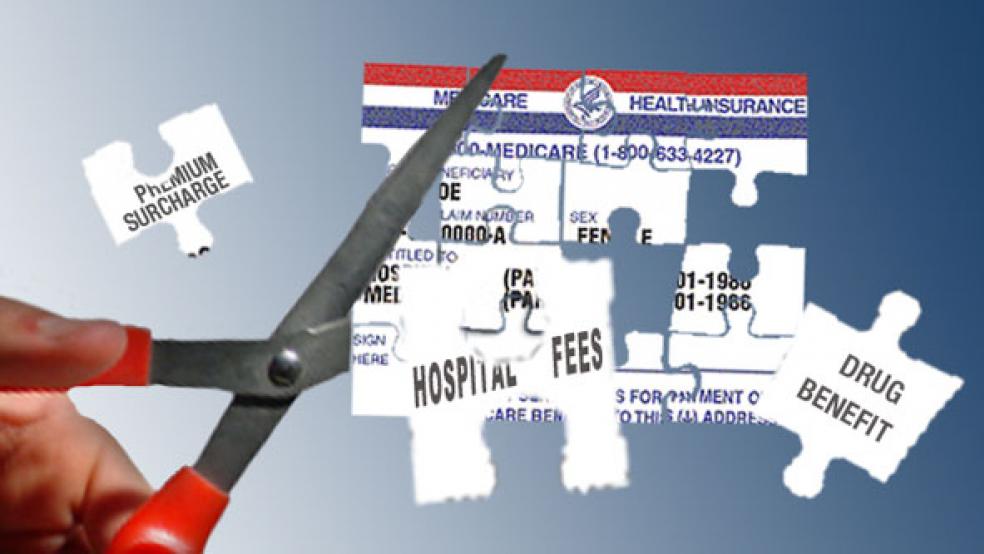President Obama’s populist message on taxes was replicated on the health savings side of his deficit-reduction plan, which would cut spending on Medicare and Medicaid by $320 billion over the next decade and $1 trillion in the following decade.
The bulk of the savings would come from companies that provide goods and services to the programs. Payments to drug companies would be slashed by $135 billion by offering seniors in Medicare the same discounts currently mandated for poor people in Medicaid. An additional $42 billion in program savings would be achieved by reducing payments to nursing homes and home health care agencies.
And those are just the major hits taken by health-care providers in the plan, which is already drawing fierce opposition from lobbyists for industries that get whacked. Rural hospitals, big city teaching hospitals, biotechnology firms, and durable equipment manufacturers also would be in for payment cuts under the Obama blueprint.
Major trade associations representing provider groups immediately blasted the proposal, playing the same jobs card the president is using. The Pharmaceutical Research and Manufacturers Association “opposes implementing Medicaid’s failed price controls in Medicare Part D,” the group said in a prepared statement. “Such policies would fundamentally alter the competitive nature of the program, undermine its success, and potentially cost hundreds of thousands of American jobs.”
The American Hospital Association claimed “today’s plan to cut Medicare and Medicaid funding would translate into at least 200,000 job losses to hospitals and the businesses they support by 2021. This is the wrong prescription to create a healthier America and sustain job growth in a sector of the economy that is actually adding jobs.”
And in a move that will provide fodder for the conservative blogosphere, the plan renews the president’s call from last April to strengthen the Independent Payments Advisory Board.
Created by the Affordable Care Act, the 15-member IPAB under the administration’s latest plan would be required to ratchet down health-care spending growth to a rate equal to gross domestic product plus ½ of 1 percent, instead of the GDP + 1% contained in the original reform law. Republican attacks on IPAB as a harbinger of “death panels” helped the party win control of the House last year.
Companies in the Biotechnology Industry Organization, which face a shortened period of exclusivity from 12 years to 7 for their pricey biotech drugs under the proposal, also blasted the IPAB section of the Obama plan. “IPAB could enact broad changes to Medicare without congressional oversight,” said former Republican Congressman Jim Greenwood, who now heads the group. “Repealing IPAB is essential to protecting American access to quality medical care.”
Given reactions like that from providers, it’s clear that what sells with the president’s political base doesn’t stand much of a chance on Capitol Hill, analysts said. “I don’t think there’s any appetite for this in the House,” said Dan Mendelson, CEO of Avalere Health, a research and consulting firm. “This plan is a very political document.”
Yet the fine print of the document suggests the president didn’t entirely let beneficiaries, state governments, or low-income communities off the hook. While their share of “shared sacrifice” is significantly smaller than the wounds suffered by the drug industry, the plan nonetheless would:
- Reduce federal subsidies for higher-income Medicare beneficiaries by increasing premiums for physician visit and drug coverage by 15 percent: a quarter of all seniors in the program would have to pay higher premiums ($20 billion over 10 years).
- Add a premium surcharge for Medicare beneficiaries who purchase Medigap policies, which encourage them to overuse pricey yet questionable services ($2.5 billion).
• End reimbursements for the taxes that many states levy on providers but then kick back in the form of higher payments; many states use provider taxes as a backdoor way of increasing the amount of Medicaid money they get from the federal government ($26.3 billion). - Reduce the extra payments paid to hospitals that serve a disproportionate share of poor people, since many of these previously uninsured citizens will soon get coverage through the Affordable Care Act (under health-care reform).
There is one element of the plan that should please both sides. The president proposed cutting ACA subsidies for seniors who qualify for Medicaid by counting their Social Security payments as income. The failure to do so was considered a glitch in reform law.
However, the $14.6 billion over the next 10 years raised from low-income seniors has already been targeted by both Republicans and Democrats on the Hill to help pay for keeping physician payment rates stable next year. The Congressional Budget Office estimates a permanent fix will cost $300 billion over the next decade.
The latest Obama plan leaves it to Congress to deal with the so-called “doc fix.” However, it does call for a permanent repeal of the formula, which won immediate support from the American Medical Association.
Don’t count on that happening anytime soon. “The ‘doc fix' has become an annuity for the campaign contribution of politicians,” said Avalere’s Mendelson,” so it’s hard to see there ever being a permanent fix.”





